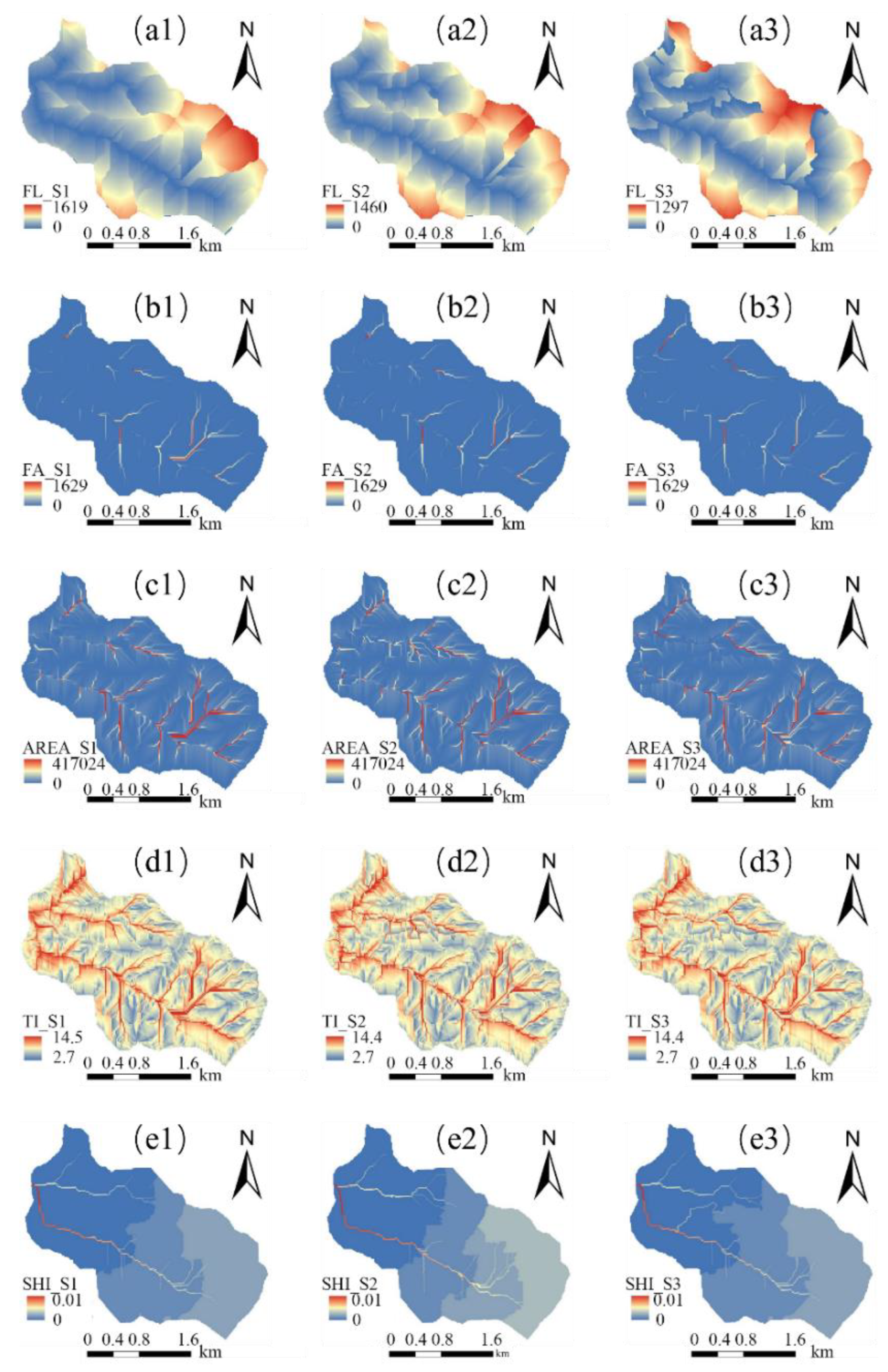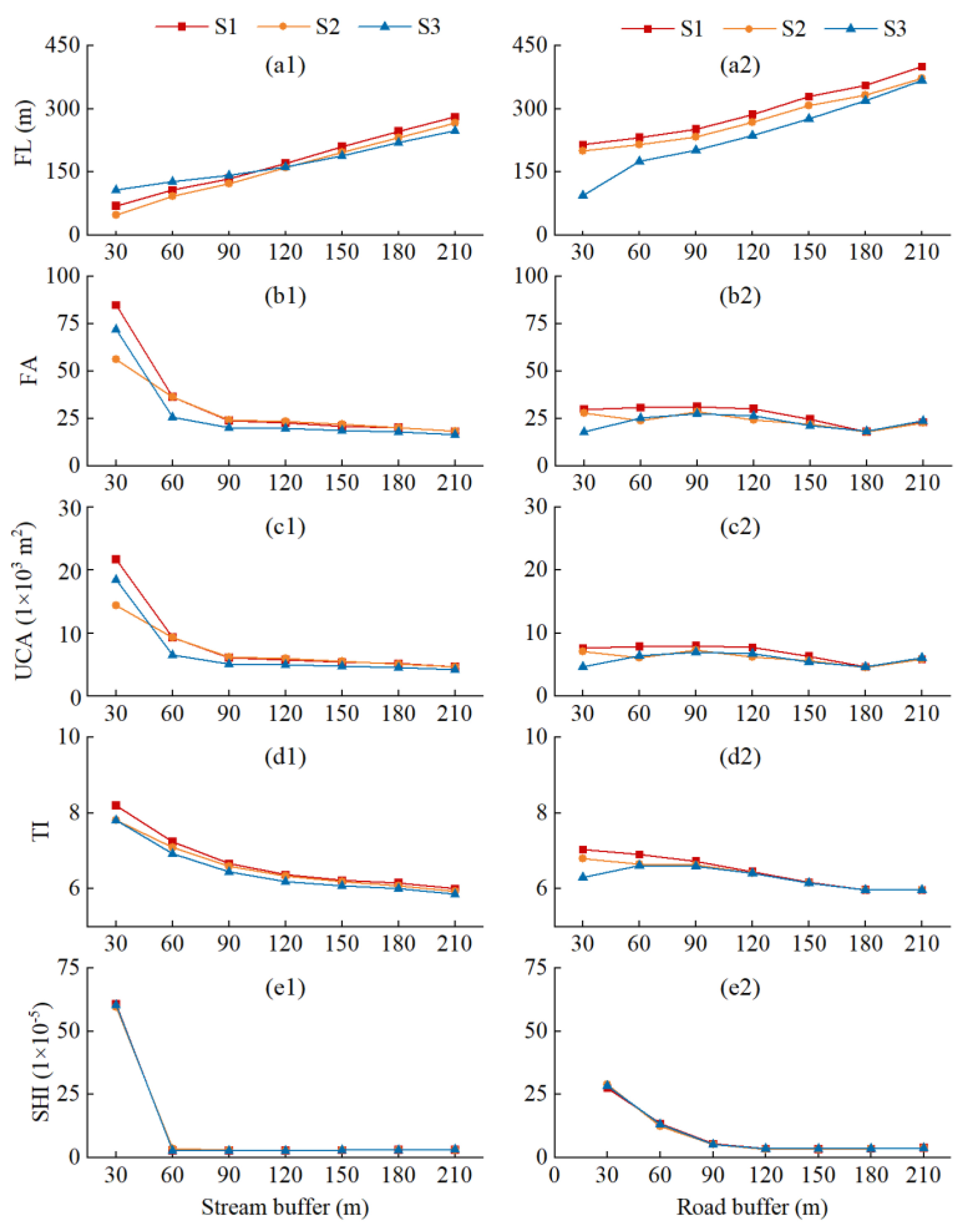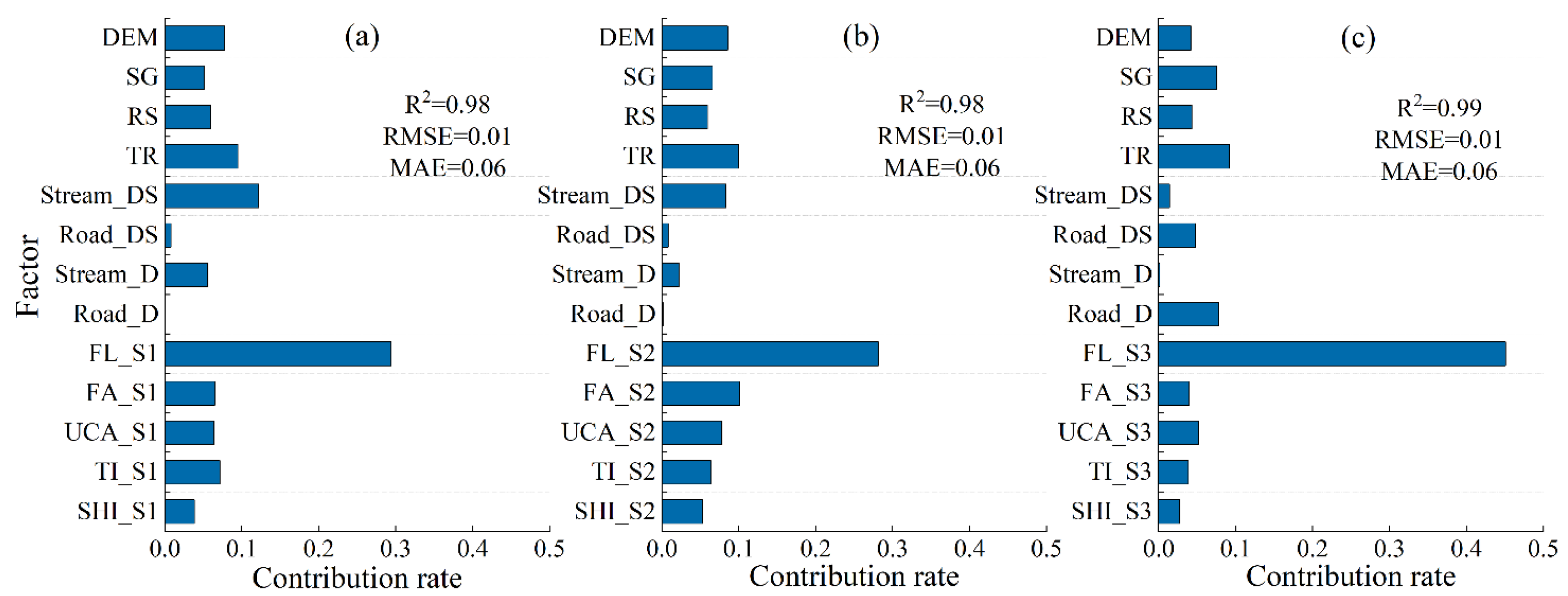Response of Sediment Connectivity to Altered Convergence Processes Induced by Forest Roads in Mountainous Watershed
Abstract
:1. Introduction
2. Materials and Methods
2.1. Study Area
2.2. Data Acquisition
2.3. Altered Transport Pathways by Road Networks
2.4. Response Variables
2.4.1. Flow Length
2.4.2. Flow Accumulation
2.4.3. Upslope Contributing Area
2.4.4. Topographic Index
2.4.5. Accessibility
2.4.6. Terrain Relief
2.4.7. Characteristics of Road and Stream Networks
2.5. Sediment Connectivity
2.6. Buffer Analysis
2.7. Extremely Randomized Tree Model
2.8. Multiscale Geographically Weighted Regression
3. Results
3.1. Response of Convergence Processes to Forest Roads
3.2. Response of Sediment Connectivity to Forest Roads
3.3. Spatial Relationship between Sediment Connectivity and Convergence Processes
3.3.1. Contribution of Influencing Factors to Sediment Connectivity
3.3.2. Spatial Variation in the Relationships between Sediment Connectivity and Primary Influencing Factors
4. Discussion
4.1. Convergence Processes Altered by Forest Roads
4.2. Sediment Connectivity in Response to Forest Roads
4.3. Relationship between Sediment Connectivity and Environmental Factors Associated with Forest Roads
5. Conclusions
Author Contributions
Funding
Data Availability Statement
Acknowledgments
Conflicts of Interest
References
- Ballantyne, M.; Pickering, C.M. The impacts of trail infrastructure on vegetation and soils: Current literature and future directions. J. Environ. Manag. 2015, 164, 53–64. [Google Scholar] [CrossRef] [Green Version]
- Sugden, B.D. Estimated sediment reduction with forestry best management practices implementation on a legacy forest road network in the northern Rocky Mountains. For. Sci. 2018, 64, 214–224. [Google Scholar] [CrossRef]
- Surfleet, C.G.; Marks, S.J. Hydrologic and suspended sediment effects of forest roads using field and DHSVM modelling studies. For. Ecol. Manag. 2021, 499, 119632. [Google Scholar] [CrossRef]
- Kazama, V.S.; Corte, A.P.D.; Robert, R.C.G.; Sanquetta, C.R.; Arce, J.E.; Oliveira-Nascimento, K.A.; DeArmond, D. Global review on forest road optimization planning: Support for sustainable forest management in Amazonia. For. Ecol. Manag. 2021, 492, 119159. [Google Scholar] [CrossRef]
- Guo, W.; Bai, Y.; Cui, Z.; Wang, W.; Li, J.; Su, Z. The impact of concentrated flow and slope on unpaved loess-road erosion on the Chinese Loess Plateau. Land Degrad. Dev. 2021, 32, 914–925. [Google Scholar] [CrossRef]
- Ramos-Scharrón, C.E. Land disturbance effects of roads in runoff and sediment production on dry-tropical settings. Geoderma 2018, 310, 107–119. [Google Scholar] [CrossRef] [Green Version]
- Touma, B.R.; Kondolf, G.M.; Walls, S. Impacts of sediment derived from erosion of partially-constructed road on aquatic organisms in a tropical river: The Río San Juan, Nicaragua and Costa Rica. PLoS ONE 2020, 15, e0242356. [Google Scholar]
- Ramos-Scharrón, C.E. Impacts of off-road vehicle tracks on runoff, erosion and sediment delivery—A combined field and modeling approach. Environ. Model. Softw. 2021, 136, 104957. [Google Scholar] [CrossRef]
- Croke, J.C.; Hairsine, P.B. Sediment delivery in managed forests: A review. Environ. Rev. 2006, 14, 59–87. [Google Scholar] [CrossRef]
- Jaafari, A.; Najafi, A.; Rezaeian, J.; Sattarian, A. Modeling erosion and sediment delivery from unpaved roads in the north mountainous forest of Iran. GEM—Int. J. Geomath. 2015, 6, 343–356. [Google Scholar] [CrossRef]
- Cao, L.; Zhang, K.; Dai, H.; Liang, Y. Modeling interrill erosion on unpaved roads in the loess plateau of China. Land Degrad. Dev. 2015, 26, 825–832. [Google Scholar] [CrossRef]
- Liu, Y.-J.; Hu, J.-M.; Wang, T.-W.; Cai, C.-F.; Li, Z.-X.; Zhang, Y. Effects of vegetation cover and road-concentrated flow on hillslope erosion in rainfall and scouring simulation tests in the Three Gorges Reservoir Area, China. Catena 2016, 136, 108–117. [Google Scholar] [CrossRef]
- Mahoney, D.; Blandford, B.; Fox, J. Coupling the probability of connectivity and RUSLE reveals pathways of sediment transport and soil loss rates for forest and reclaimed mine landscapes. J. Hydrol. 2021, 594, 125963. [Google Scholar] [CrossRef]
- Fu, B.; Newham, L.T.; Ramos-Scharron, C. A review of surface erosion and sediment delivery models for unsealed roads. Environ. Model. Softw. 2010, 25, 1–14. [Google Scholar] [CrossRef]
- Napieralski, J.A.; Giroux, B. Quantifying proximity and conformity between road networks, urban streams, and watershed boundaries. Ann. Am. Assoc. Geogr. 2019, 109, 35–49. [Google Scholar] [CrossRef]
- Croke, J.; Mockler, S.; Fogarty, P.; Takken, I. Sediment concentration changes in runoff pathways from a forest road network and the resultant spatial pattern of catchment connectivity. Geomorphology 2005, 68, 257–268. [Google Scholar] [CrossRef]
- Sosa-Pérez, G.; MacDonald, L. Wildfire effects on road surface erosion, deposition, and road–stream connectivity. Earth Surf. Process. Landf. 2017, 42, 735–748. [Google Scholar] [CrossRef]
- Pechenick, A.M.; Rizzo, D.M.; Morrissey, L.A.; Garvey, K.M.; Underwood, K.L.; Wemple, B.C. A multi-scale statistical approach to assess the effects of connectivity of road and stream networks on geomorphic channel condition. Earth Surf. Process. Landf. 2015, 39, 1538–1549. [Google Scholar] [CrossRef]
- Johnson, J.C.; Williams, C.J.; Guertin, D.P.; Archer, S.R.; Heilman, P.; Pierson, F.B.; Wei, H. Restoration of a shrub-encroached semi-arid grassland: Implications for structural, hydrologic, and sediment connectivity. Ecohydrology 2021, 14, e2281. [Google Scholar] [CrossRef]
- Alfonso-Torreño, A.; Schnabel, S.; Gómez-Gutiérrez, Á.; Crema, S.; Cavalli, M. Effects of gully control measures on sediment yield and connectivity in wooded rangelands. Catena 2022, 214, 106259. [Google Scholar] [CrossRef]
- Persichillo, M.G.; Bordoni, M.; Cavalli, M.; Crema, S.; Meisina, C. The role of human activities on sediment connectivity of shallow landslides. Catena 2018, 160, 261–274. [Google Scholar] [CrossRef]
- Negishi, J.N.; Sidle, R.C.; Ziegler, A.D.; Noguchi, S.; Rahim, N.A. Contribution of intercepted subsurface flow to road runoff and sediment transport in a logging-disturbed tropical catchment. Earth Surf. Process. Landf. 2008, 33, 1174–1191. [Google Scholar] [CrossRef]
- Fidelus-Orzechowska, J.; Strzyżowski, D.; Żelazny, M. The geomorphic activity of forest roads and its dependencies in the Tatra Mountains. Geogr. Ann. Ser. A Phys. Geogr. 2018, 100, 59–74. [Google Scholar] [CrossRef]
- Hernani, H. Application of LiDAR DEM Metrics to Estimate Road-stream Sediment Connectivity in Alberta Eastslopes Salmonid Habitats; University of Alberta: Edmonton, AB, Canada, 2019. [Google Scholar]
- Sosa-Pérez, G.; MacDonald, L.H. Reductions in road sediment production and road-stream connectivity from two decommissioning treatments. For. Ecol. Manag. 2017, 398, 116–129. [Google Scholar] [CrossRef]
- Lin, H.Y.; Robinson, K.F.; Walter, L. Trade-offs among road–stream crossing upgrade prioritizations based on connectivity restoration and erosion risk control. River Res. Appl. 2020, 36, 371–382. [Google Scholar] [CrossRef]
- Lang, A.J.; Aust, W.M.; Bolding, M.C.; McGuire, K.J.; Schilling, E.B. Best management practices influence sediment delivery from road stream crossings to mountain and piedmont streams. For. Sci. 2018, 64, 682–695. [Google Scholar] [CrossRef]
- Thomaz, E.L.; Peretto, G.T. Hydrogeomorphic connectivity on roads crossing in rural headwaters and its effect on stream dynamics. Sci. Total Environ. 2016, 550, 547–555. [Google Scholar] [CrossRef] [PubMed]
- Llena, M.; Vericat, D.; Cavalli, M.; Crema, S.; Smith, M.W. The effects of land use and topographic changes on sediment connectivity in mountain catchments. Sci. Total Environ. 2019, 660, 899–912. [Google Scholar] [CrossRef] [PubMed] [Green Version]
- Trevisani, S.; Cavalli, M. Topography-based flow-directional roughness: Potential and challenges. Earth Surf. Dyn. 2016, 4, 343–358. [Google Scholar] [CrossRef] [Green Version]
- Forsyth, A.; Bubb, K.; Cox, M. Runoff, sediment loss and water quality from forest roads in a southeast Queensland coastal plain Pinus plantation. For. Ecol. Manag. 2006, 221, 194–206. [Google Scholar] [CrossRef]
- Viel, V.; Delahaye, D.; Reulier, R. Evaluation of slopes delivery to catchment sediment budget for a low-energy water system: A case study from the Lingèvres catchment (Normandy, western France). Geogr. Ann. Ser. A Phys. Geogr. 2014, 96, 497–511. [Google Scholar] [CrossRef]
- Fressard, M.; Cossart, E. A graph theory tool for assessing structural sediment connectivity: Development and application in the Mercurey vineyards (France). Sci. Total Environ. 2019, 651, 2566–2584. [Google Scholar] [CrossRef] [PubMed]
- Akhtar, M.K.; Corzo, G.A.; Van Andel, S.J.; Jonoski, A. River flow forecasting with artificial neural networks using satellite observed precipitation pre-processed with flow length and travel time information: Case study of the Ganges river basin. Hydrol. Earth Syst. Sci. 2009, 13, 1607–1618. [Google Scholar] [CrossRef] [Green Version]
- Barnes, R. Parallel non-divergent flow accumulation for trillion cell digital elevation models on desktops or clusters. Environ. Model. Softw. 2017, 92, 202–212. [Google Scholar] [CrossRef] [Green Version]
- Quinn, P.; Beven, K.; Chevallier, P.; Planchon, O. The prediction of hillslope flow paths for distributed hydrological modelling using digital terrain models. Hydrol. Process. 1991, 5, 59–79. [Google Scholar] [CrossRef]
- Beven, K.J.; Kirkby, M.; Schofield, N.; Tagg, A. Testing a physically-based flood forecasting model (TOPMODEL) for three UK catchments. J. Hydrol. 1984, 69, 119–143. [Google Scholar] [CrossRef]
- Zhang, D.-G.; Wang, K.-L.; Chen, H.-S.; Li, X.; Wang, S.-G. Method and application for extracting topographic index based on DEM. Resour. Environ. Yangtze Basin 2005, 14, 714–719. [Google Scholar]
- Feng, Z.; Li, W.; Li, P.; Xiao, C. Relief degree of land surface and its geographical meanings in the Qinghai-Tibet Plateau, China. Acta Geogr. Sin. 2020, 75, 1359–1372. [Google Scholar]
- Borselli, L.; Cassi, P.; Torri, D. Prolegomena to sediment and flow connectivity in the landscape: A GIS and field numerical assessment. Catena 2008, 75, 268–277. [Google Scholar] [CrossRef]
- López-Vicente, M.; Poesen, J.; Navas, A.; Gaspar, L. Predicting runoff and sediment connectivity and soil erosion by water for different land use scenarios in the Spanish Pre-Pyrenees. Catena 2013, 102, 62–73. [Google Scholar] [CrossRef]
- Cavalli, M.; Trevisani, S.; Comiti, F.; Marchi, L. Geomorphometric assessment of spatial sediment connectivity in small Alpine catchments. Geomorphology 2013, 188, 31–41. [Google Scholar] [CrossRef]
- Zanandrea, F.; Michel, G.P.; Kobiyama, M. Impedance influence on the index of sediment connectivity in a forested mountainous catchment. Geomorphology 2020, 351, 106962. [Google Scholar] [CrossRef]
- Zheng, Z.; He, S.; Wu, F.; Hu, J. Relationship between surface roughness and Manning roughness. Mt. Res. 2004, 22, 236–239. [Google Scholar]
- Chakraborty, J.; Armstrong, M.P. Exploring the use of buffer analysis for the identification of impacted areas in environmental equity assessment. Cartogr. Geogr. Inf. Syst. 1997, 24, 145–157. [Google Scholar] [CrossRef]
- Geurts, P.; Ernst, D.; Wehenkel, L. Extremely randomized trees. Mach. Learn. 2006, 63, 3–42. [Google Scholar] [CrossRef] [Green Version]
- Li, F.; Gong, H.; Chen, B.; Zhou, C.; Guo, L. Analysis of the contribution rate of the influencing factors to land subsidence in the Eastern Beijing plain, China based on extremely randomized trees (ERT) method. Remote Sens. 2020, 12, 2963. [Google Scholar] [CrossRef]
- Fotheringham, A.S.; Yang, W.; Kang, W. Multiscale geographically weighted regression (MGWR). Ann. Am. Assoc. Geogr. 2017, 107, 1247–1265. [Google Scholar] [CrossRef]
- Yu, H.; Fotheringham, A.S.; Li, Z.; Oshan, T.; Kang, W.; Wolf, L.J. Inference in multiscale geographically weighted regression. Geogr. Anal. 2020, 52, 87–106. [Google Scholar] [CrossRef]
- Dormann, C.F.; Elith, J.; Bacher, S.; Buchmann, C.; Carl, G.; Carré, G.; Marquéz, J.R.G.; Gruber, B.; Lafourcade, B.; Leitão, P.J. Collinearity: A review of methods to deal with it and a simulation study evaluating their performance. Ecography 2013, 36, 27–46. [Google Scholar] [CrossRef]
- Wemple, B.C.; Clark, G.E.; Ross, D.S.; Rizzo, D.M. Identifying the spatial pattern and importance of hydro-geomorphic drainage impairments on unpaved roads in the northeastern USA. Earth Surf. Process. Landf. 2017, 42, 1652–1665. [Google Scholar] [CrossRef]
- Zhao, Y.; Zhang, Y.; Yuan, M.; Yang, M.; Deng, J. Estimation of initiation thresholds and soil loss from gully erosion on unpaved roads on China’s Loess Plateau. Earth Surf. Process. Landf. 2021, 46, 1713–1724. [Google Scholar] [CrossRef]
- Sandercock, P.; Hooke, J. Assessment of vegetation effects on hydraulics and of feedbacks on plant survival and zonation in ephemeral channels. Hydrol. Process. Int. J. 2010, 24, 695–713. [Google Scholar] [CrossRef]
- Wemple, B.C.; Browning, T.; Ziegler, A.D.; Celi, J.; Chun, K.P.; Jaramillo, F.; Leite, N.K.; Ramchunder, S.J.; Negishi, J.N.; Palomeque, X.; et al. Ecohydrological disturbances associated with roads: Current knowledge, research needs, and management concerns with reference to the tropics. Ecohydrology 2018, 11, e1881. [Google Scholar] [CrossRef]
- Marcantonio, M.; Rocchini, D.; Geri, F.; Bacaro, G.; Amici, V. Biodiversity, roads, & landscape fragmentation: Two Mediterranean cases. Appl. Geogr. 2013, 42, 63–72. [Google Scholar]
- Rinderer, M.; Ali, G.; Larsen, L.G. Assessing structural, functional and effective hydrologic connectivity with brain neuroscience methods: State-of-the-art and research directions. Earth-Sci. Rev. 2018, 178, 29–47. [Google Scholar] [CrossRef]
- Park, E. Characterizing channel-floodplain connectivity using satellite altimetry: Mechanism, hydrogeomorphic control, and sediment budget. Remote Sens. Environ. 2020, 243, 111783. [Google Scholar] [CrossRef]
- Jing, Y.; Zhao, Q.; Lu, M.; Wang, A.; Yu, J.; Liu, Y.; Ding, S. Effects of road and river networks on sediment connectivity in mountainous watersheds. Sci. Total Environ. 2022, 826, 154189. [Google Scholar] [CrossRef]
- Tarolli, P.; Calligaro, S.; Cazorzi, F.; Fontana, G.D. Recognition of surface flow processes influenced by roads and trails in mountain areas using high-resolution topography. Eur. J. Remote Sens. 2013, 46, 176–197. [Google Scholar] [CrossRef]
- Cossart, É.; Fressard, M. Assessment of structural sediment connectivity within catchments: Insights from graph theory. Earth Surf. Dyn. 2017, 5, 253–268. [Google Scholar] [CrossRef] [Green Version]
- Brown, K.R.; Aust, W.M.; Mcguire, K.J. Sediment delivery from bare and graveled forest road stream crossing approaches in the Virginia Piedmont. For. Ecol. Manag. 2013, 310, 836–846. [Google Scholar] [CrossRef]
- Puigdefábregas, J.; Sole, A.; Gutierrez, L.; Del Barrio, G.; Boer, M. Scales and processes of water and sediment redistribution in drylands: Results from the Rambla Honda field site in Southeast Spain. Earth-Sci. Rev. 1999, 48, 39–70. [Google Scholar] [CrossRef]
- Cammeraat, E.L. Scale dependent thresholds in hydrological and erosion response of a semi-arid catchment in southeast Spain. Agric. Ecosyst. Environ. 2004, 104, 317–332. [Google Scholar] [CrossRef]
- Thompson, C.J.; Takken, I.; Croke, J.; Schmidt, J.; Cochrane, T.; Phillips, C.; Elliott, S.; Davies, T.; Basher, L. Hydrological and Sedimentological Connectivity of Unsealed Roads. In Proceedings of the 2008 Symposium of the International Commission on Continental Erosion, Christchurch, New Zealand, 1–5 December 2008. [Google Scholar]









Publisher’s Note: MDPI stays neutral with regard to jurisdictional claims in published maps and institutional affiliations. |
© 2022 by the authors. Licensee MDPI, Basel, Switzerland. This article is an open access article distributed under the terms and conditions of the Creative Commons Attribution (CC BY) license (https://creativecommons.org/licenses/by/4.0/).
Share and Cite
Zhao, Q.; Jing, Y.; Wang, A.; Yu, Z.; Liu, Y.; Yu, J.; Liu, G.; Ding, S. Response of Sediment Connectivity to Altered Convergence Processes Induced by Forest Roads in Mountainous Watershed. Remote Sens. 2022, 14, 3603. https://doi.org/10.3390/rs14153603
Zhao Q, Jing Y, Wang A, Yu Z, Liu Y, Yu J, Liu G, Ding S. Response of Sediment Connectivity to Altered Convergence Processes Induced by Forest Roads in Mountainous Watershed. Remote Sensing. 2022; 14(15):3603. https://doi.org/10.3390/rs14153603
Chicago/Turabian StyleZhao, Qinghe, Yaru Jing, An Wang, Zaihui Yu, Yi Liu, Jinhai Yu, Guoshun Liu, and Shengyan Ding. 2022. "Response of Sediment Connectivity to Altered Convergence Processes Induced by Forest Roads in Mountainous Watershed" Remote Sensing 14, no. 15: 3603. https://doi.org/10.3390/rs14153603
APA StyleZhao, Q., Jing, Y., Wang, A., Yu, Z., Liu, Y., Yu, J., Liu, G., & Ding, S. (2022). Response of Sediment Connectivity to Altered Convergence Processes Induced by Forest Roads in Mountainous Watershed. Remote Sensing, 14(15), 3603. https://doi.org/10.3390/rs14153603






